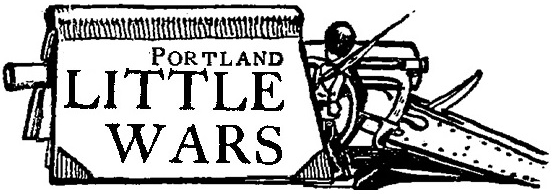 I just re-situated my games table to the opposite corner of the basement, where it 'floats' with not one edge pushed up against a wall. This is visually more appealing and also increases the playing-board significantly – when the table was up against a wall, one would unconsciously cede up to 12" of that part of the table because the wall was there. We broke out the long unseen 54mm Seven Years War collection and ended up having two inaugural games (since the first game ended so quickly – see below) with this new set-up.
I just re-situated my games table to the opposite corner of the basement, where it 'floats' with not one edge pushed up against a wall. This is visually more appealing and also increases the playing-board significantly – when the table was up against a wall, one would unconsciously cede up to 12" of that part of the table because the wall was there. We broke out the long unseen 54mm Seven Years War collection and ended up having two inaugural games (since the first game ended so quickly – see below) with this new set-up.

The games featured only the "BMC" figures (named after sculptor Bill McMaster) since some of my cavalry units (modified HAT Napoleonic dragoons) were damaged, and I never thought they matched up very well stylistically with the BMC artillery and infantry. So there we had it: five battalions or companies or whatever of Allied (mostly Hanoverians with some Hessians, Brunswickers, and British) infantry supported by two guns versus six units of French infantry also supported by two guns. The paint schemes and banners are all drawn from the orders of battle for Minden in 1759. These games were not a re-fight of the actual Minden – but Minden is its inspiration.

We used the All the Kings Men rules, but I made some changes – (1) ditched the deuce and joker card draw effects; (2) turned the King card effect into rally one unit back to green status; (3) ditched all rules for generals; (4) ditched downgrading color for anything other than taking casualties or being in melee; (5) added activation to rally and upgrade by one color level; (6) units are movement bases, so no figure removal; and (7) added simple victory conditions of automatic victory if you could get two units in contact with opposite board edge ("breaking the enemy lines"), which seemed reasonable given lack of cavalry.
Above and below: Hanoverian troops on the Allied left.
Below: fighting in the woods.
Below: the French advance begins.
Above and below: French units victorious in the center.
The lack of color downgrading meant that a good run on the card draws ended up with the French advancing clear across the field in the face of the Hanoverian artillery unscathed and knocking both out without taking a single casualty or any kind of fatigue at all! Artillery in fact was completely useless, since targeted units were always at green (so counter-rolls to cancel hits against artillery fire were always on a 4+, and since they were rolling 12 dice vs. the artillery's 8, it was a bit of a non-contest).
The game lasted about 20 minutes and saw both Allied artillery units plus two infantry units put to flight, which equaled more than half so the entire army withdrew from the field.
























